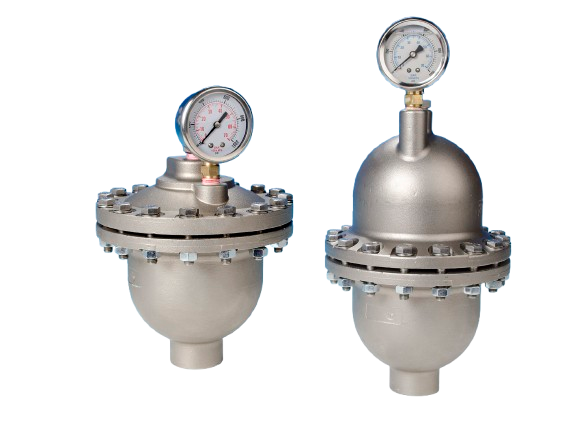Pulsation dampeners are devices designed to reduce pressure fluctuations and pulsations in fluid systems, especially in systems using reciprocating pumps such as diaphragm, piston, and plunger pumps. These pumps create pressure pulses in the fluid flow due to their cyclic action, which can lead to vibration, noise, and potential system wear. By dampening these pulsations, pulsation dampeners protect system components, improve flow stability, and help maintain precise dosing in applications across industries such as water treatment, chemical processing, food production, and oil and gas.

Key Components:
- Bladder or Diaphragm: Separates the gas and liquid sections within the dampener, allowing compression without fluid mixing.
- Gas Chamber: Contains a compressible gas, usually nitrogen, which absorbs the energy of the pressure pulse.
- Fluid Chamber: The part of the dampener that interfaces directly with the liquid in the piping system.
- Body/Housing: The outer casing, typically made of durable materials such as stainless steel or PVC, depending on the fluid and operating conditions.
- Gas Valve: Allows for the filling and adjusting of gas pressure in the dampener, tailoring its effectiveness to specific pulsation levels.
How It Works:
- Pulsation Absorption: As the pump creates pressure pulses, these pulses force liquid into the dampener’s fluid chamber, compressing the gas on the opposite side of the bladder or diaphragm.
- Energy Storage: The compressed gas absorbs the energy from the pressure pulse, dampening the spike in pressure and storing the energy temporarily.
- Energy Release: When the pressure in the system decreases, the compressed gas expands, pushing the liquid back into the system. This release smooths out the flow, creating a more consistent pressure profile.
- Continuous Cycle: With each pump stroke, the dampener absorbs and releases energy, continuously smoothing the flow as long as the system operates.
Types of Pulsation Dampeners:
- Bladder-Type: Utilizes a bladder to separate gas and liquid; widely used in systems where chemical compatibility is crucial.
- Diaphragm-Type: Uses a flexible diaphragm; often more durable and better suited for high-frequency pulsations.
- Piston-Type: Uses a piston to separate gas and liquid; ideal for systems with high-pressure requirements but less common than bladder and diaphragm types.
Benefits:
- Reduced System Vibration: By smoothing out pressure pulses, pulsation dampeners prevent vibrations that could damage pipes, fittings, and other system components.
- Increased Flow Stability: Improves flow consistency, which is crucial in dosing and metering applications for accurate chemical or fluid delivery.
- Noise Reduction: Dampens the noise generated by pulsating pumps, creating a quieter operation environment.
- Extended Equipment Life: Reduces wear on system components, including valves, seals, and piping, thereby extending the lifespan of equipment.
- Energy Efficiency: Enhances pump efficiency by lowering resistance in the piping system, which can reduce energy consumption.
Applications:
- Water Treatment: Ensures accurate dosing of chemicals by maintaining steady flow rates in dosing systems.
- Oil and Gas: Prevents pressure surges that could damage sensitive instrumentation or disrupt drilling processes.
- Food and Beverage: Protects sensitive processing equipment and maintains consistent product flow in filling and dosing applications.
- Chemical Processing: Helps handle corrosive or viscous fluids by maintaining a steady flow and reducing wear on pumps and pipes.
- Pharmaceuticals: Ensures precise dosing and protects delicate components in systems requiring hygienic and consistent flow conditions.
Selection Considerations:
- Pump Type and Pulsation Frequency: Choose a dampener that matches the frequency and amplitude of pulsations generated by the specific pump type.
- Pressure and Flow Rate: Select a dampener that can withstand the system’s operating pressure and handle required flow rates.
- Chemical Compatibility: Consider materials that are compatible with the pumped fluid to prevent degradation or contamination.
- Temperature: Ensure the dampener can operate within the temperature range of the system to maintain durability and effectiveness.
Summary:
Pulsation dampeners play an essential role in fluid systems by absorbing pressure pulses generated by reciprocating pumps. By creating a smoother, more consistent flow, these devices protect system components, improve flow accuracy, and extend equipment lifespan across multiple industries. With various types available, they can be customized for specific operational needs, ensuring efficiency, accuracy, and longevity in pulsating pump applications.
